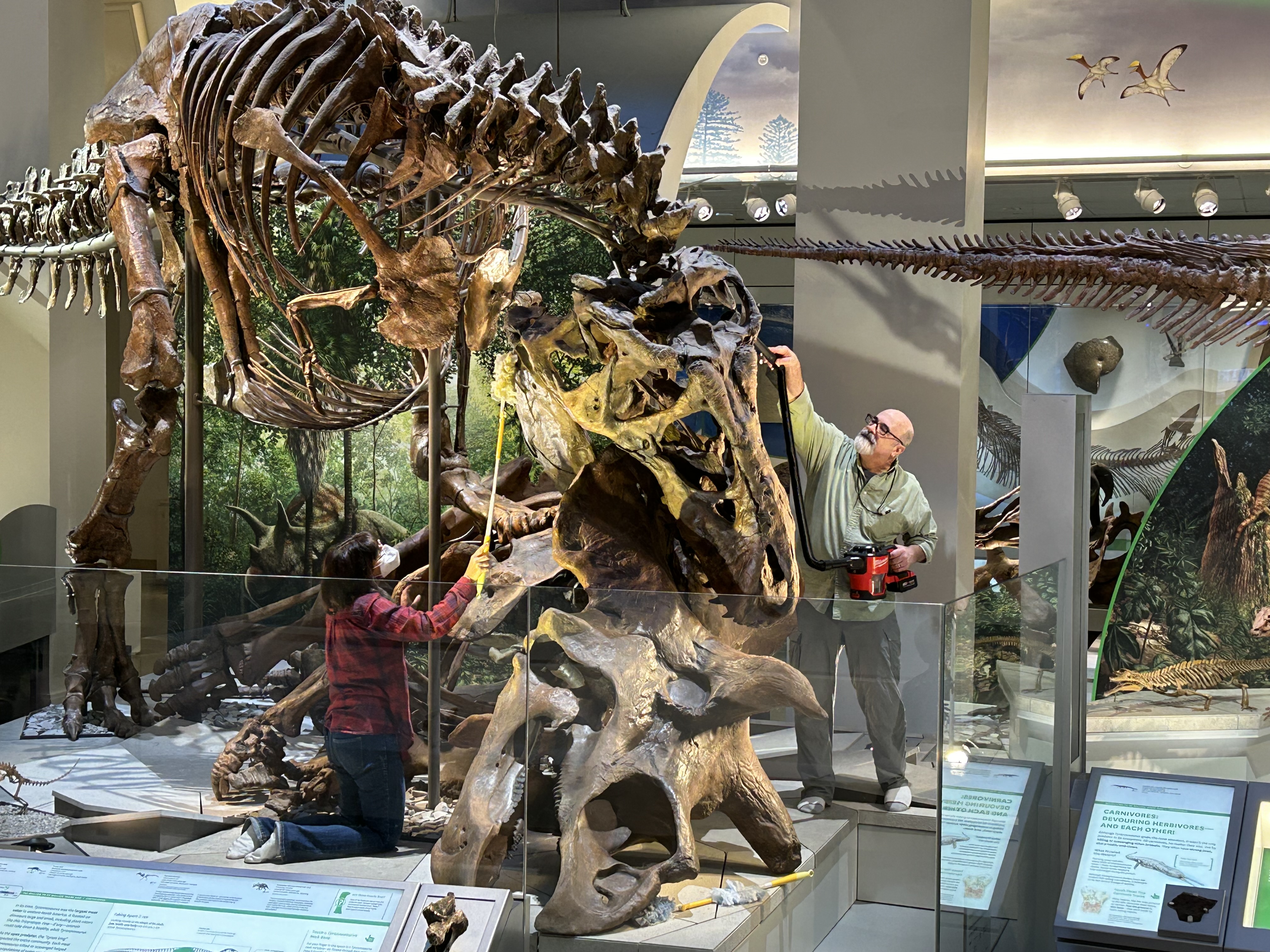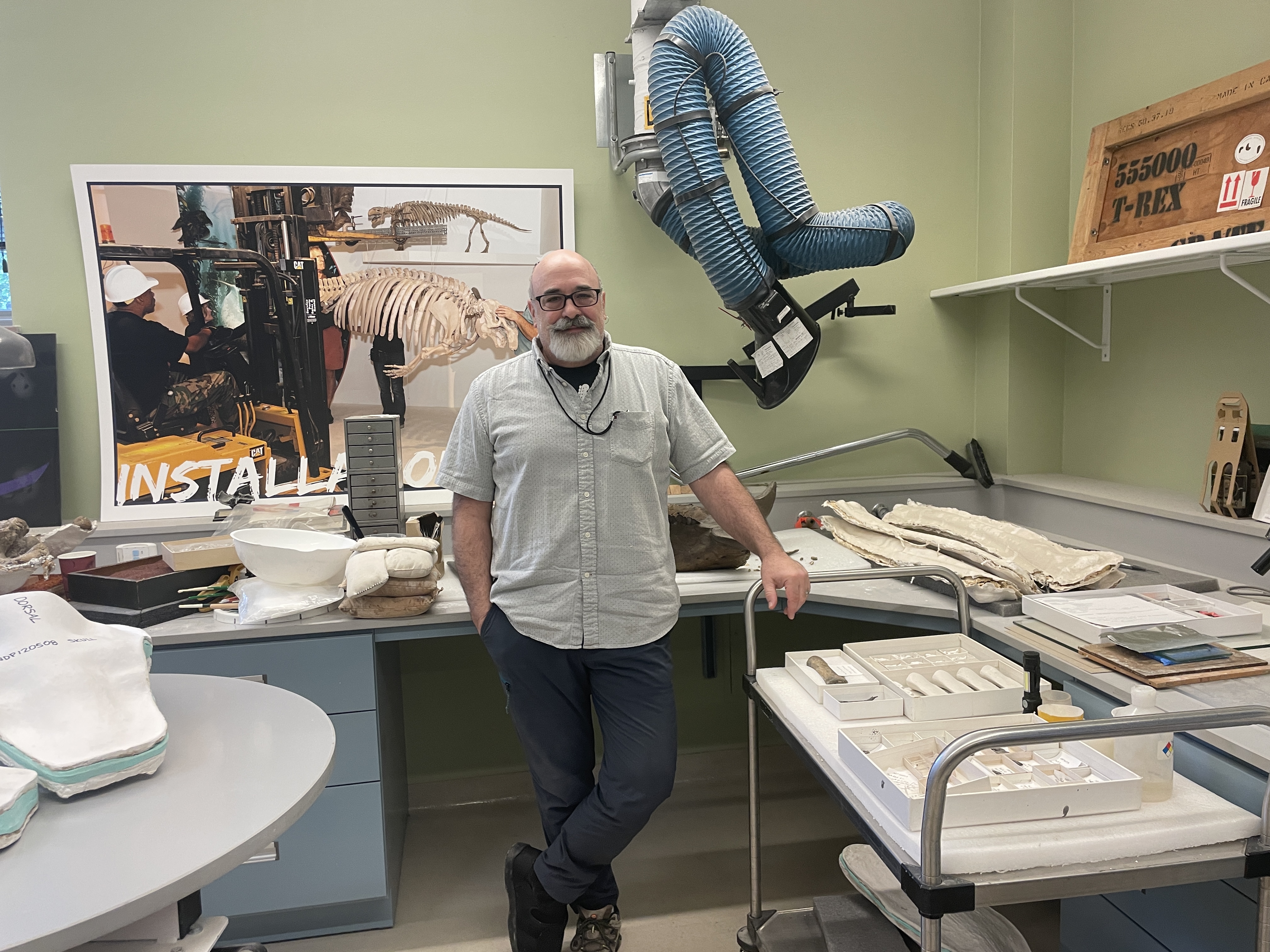NATIONAL MUSEUM OF NATURAL HISTORY
Dusting Dinosaurs and Elephants: How Specialists Keep the Museum’s Largest Treasures Spotless
To celebrate International Museum Day, learn how experts protect the museum’s most dramatic displays from dust bunnies and cobwebs

The Smithsonian Institution is often referred to as “the nation’s attic.” This makes sense from a storage perspective: The Smithsonian houses over 154 million objects, the vast majority of which are stored in the National Museum of Natural History’s collections. But unlike the boxes stored in an actual attic, the museum’s holdings are not gathering dust. These specimens are carefully prepared and curated for scientific research.
A fraction of these specimens eventually make their way into the museum’s public exhibitions. These displays are where it becomes more difficult to deter dust. Showstopping specimens like dinosaur skeletons and elephants are prone to attract dust, cobwebs and dirt as millions of visitors pass through the museum each year. But a team of experts, including Steve Jabo, one of the museum’s fossil preparators, works hard to reduce this grime and prevent dusty dinosaur bones.
This team’s work also helps protect the specimens themselves. According to Jabo, who excavates fossils from rock to prepare them for museum collections or display, even the largest fossilized bones can be extremely sensitive. “These fossil bones are much more fragile than you’d think,” Jabo explained. “They’re super brittle because they are mineralized and there is no organic material left, and they can break just under their own weight.”Most of the fragile fossils are kept safely behind the scenes in custom-fit foam-and-plaster casts called collection jackets, which keeps them protected from air, dust, and bumps. These jackets secure the fossils so they remain intact for any current or future research projects.
“That’s the real reason why we keep our fossils so well protected: we don’t want to lose data for further research,” Jabo said. There is no telling the clues that future researchers may be able to eventually find in a properly prepared and safely stored fossilized bone./https://tf-cmsv2-smithsonianmag-media.s3.amazonaws.com/filer_public/1d/6b/1d6b33fe-0c6a-4b36-b297-f2f95041e1b6/2000-7634_elephantcleaning-s.jpg)
The fossils on display are also well protected, but are more exposed to conditions like humidity, temperature changes, vibrations, human interactions and dust. Although dust doesn’t seem likely in the enclosed glass exhibits, those keeping a careful eye on the displays notice that the dust begins to settle, sometimes causing what Jabo calls a “population explosion of dust bunnies.” One time, a brave spider even spun a web between the outstretched tusks of the museum’s mastodon.
Every two to three months, it’s time for Jabo and his team to clean the fossils on display in the museum’s Deep Time Hall of Fossils. They arrive at the museum before it opens. Between 8 and 9:55 a.m., they use battery-powered backpack vacuum cleaners and Swiffer dusters to sweep up the grime on the platforms. Cleaning the display platforms alone usually takes the team three consecutive mornings.“It’s a very specialized procedure and we’re used to these mounts and know how the fossil bones work.”
—Steve Jabo, Fossil Preparator NMNH
The finer details — like a fossils’ teeth — require the more delicate attention of a feather duster or a tiny handheld vacuum. Some fossil-heavy displays have so many intricate ribs and vertebrae that it takes about five extra mornings to ensure every bone is spotless.
Then, every five or six years, the taller fossils like the 100-foot-long Diplodocus skeleton or Henry, the museum’s iconic African Bush Elephant mount, need cleaning. Since Jabo can’t reach higher than six or seven feet with his backpack vacuum or duster, the team needs to use lifts. This work is done at night when the museum is empty, leaving the cleaning crew plenty of time to dust off these massive specimens.
/https://tf-cmsv2-smithsonianmag-media.s3.amazonaws.com/filer_public/a8/02/a8025e4e-0e8a-4e5e-90ed-5cad0cb0a815/84-18604-29_dusting-elephant-rotunda-s.jpg)
Although the cleaning is time consuming, Jabo says he is happy to do it to ensure it’s done correctly. “It’s a very specialized procedure and we’re used to these mounts and know how fossil bones work,” he says. “Not everybody understands how the bones are mounted, or what you can or cannot do to them.”
Jabo gained an intimate understanding of fossils from the countless hours he has spent freeing fossilized bone from rock. He recently spent three and a half years carefully preparing the skull and jaws of a prehistoric whale from British Columbia, using a tool called an air scribe, which chips away rock like a miniature jack hammer.
What motivates Jabo to painstakingly chip away at the rock entombing a fossil or patiently dust off a dinosaur’s ribs is the awe he has for these specimens. “Every fossil is special,” he said. “These things have been around for millions of years and there's a lot of responsibility in that. You don’t want to mess it up.”
Related Stories
How Smithsonian Fossil Preparators Are Re-Excavating a Tyrannosaur From Its Past on Display
Just Our Type: Museum’s Dinosaur Skeleton Becomes the Scientific Standard for Its Species
Dino-Sore: Smithsonian Paleontologist Diagnoses Ancient Ailments in the Museum’s Dinosaurs
How WWII Service Members Helped Shape the Smithsonian’s New Fossil Hall

